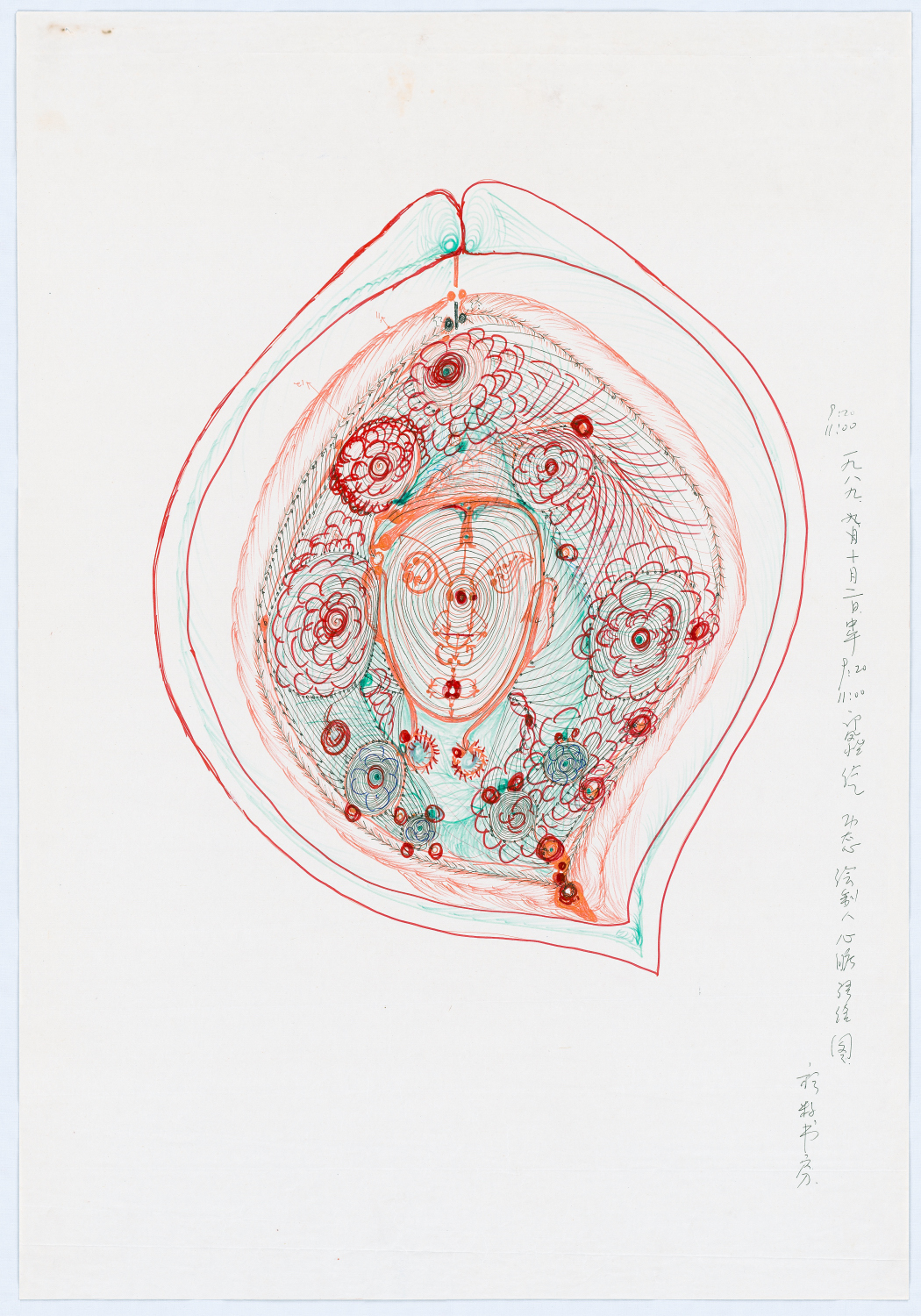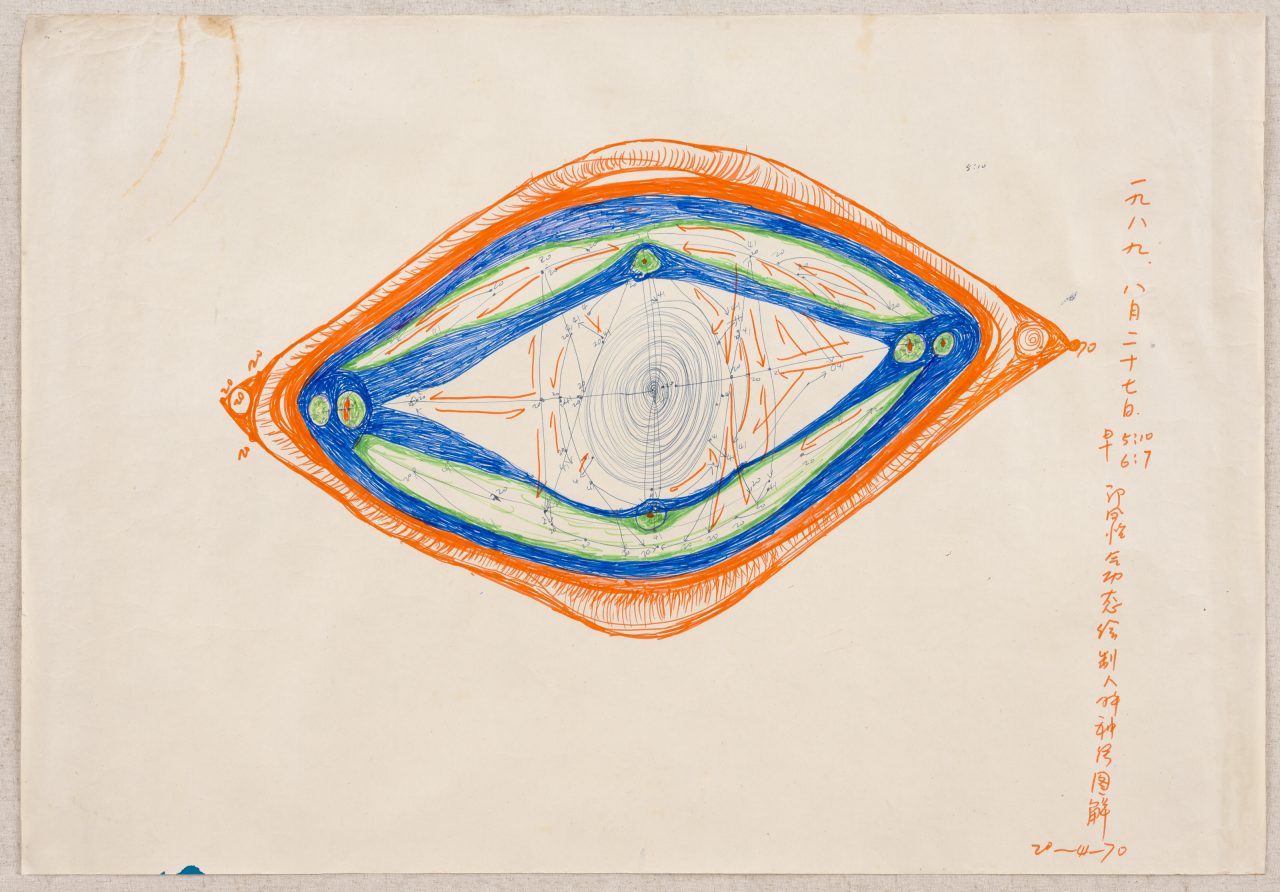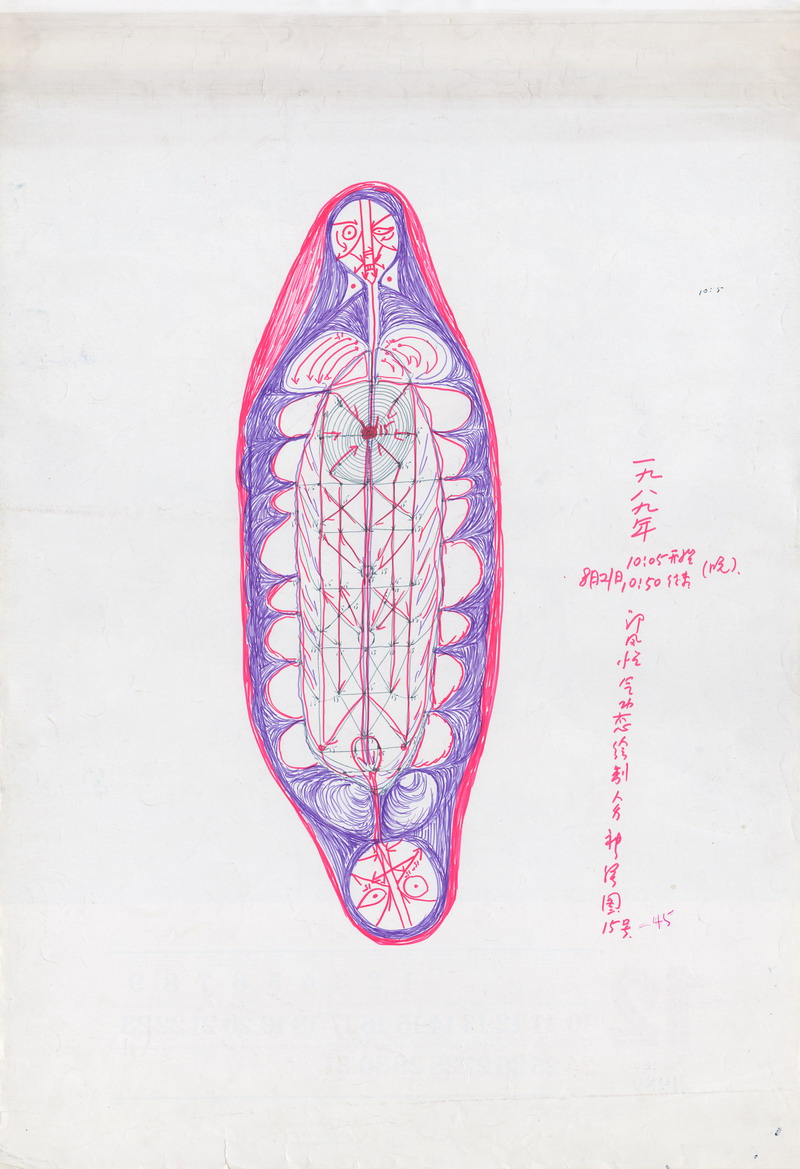Guo Fengyi: Cosmic Meridians (Ⅲ)
Duration: 18 MARCH 12:00 AM - 17 APRIL 11:59 AM (CST), 2023

According to Guo, her ways of working consist of three steps: write down the question, start to paint, and let the images emerge. If Guo Fengyi, as she claims, ‘I draw because I do not know, I draw to know’, then WHO is the one she has longed for to give out an answer? This question almost summons back an ancient shamanic scene that connects the land and the heaven, making it possible to rewrite Guo’s set of movements into ‘place the request, launch the ritual, and let the divine response appear’.
To paint like this, perhaps, is Guo Fengyi’s only and final self-expression. We must, however, realise that perception is the same as time in terms of restless changes. Folk art or art brut, modern art or contemporary art, Guo Fengyi is never a ‘reasonable experience’ that complies with one single system of rules.
Thereupon, to talk about Guo Fengyi’s paintings is not only to render a type of painting, a kind of method of reading, or the legitimacy of a sort of art; her paintings are also an accidental phenomenon that never leaves aside its many contextualisations, including the social background, historical context, political situation, and cultural wrestling. More importantly, her paintings inspire us to talk about the way to act in a world of constant conflicts and changes.
--Excerpted from Wang Huan's Introduction for the exhibition Guo Fengyi: Cosmic Meridians
About Guo Fengyi
Guo Fengyi (1942–2010, Xi’an, China) is a self-trained female artist whose artistic practice articulates a particular journey of spiritual and metaphysical significance, belonging to an older generation whose embrace of Chinese folk culture imparts a unique knowledge of history, myth, and mystery. Her works on paper are composed of finely controlled brushwork that blend and weave into a composition of lustrous images; suggestions of both human figures and otherworldly beings.
Guo Fengyi began practicing Qigong (a traditional Chinese health maintenance practice that cultivates the qi energy within the body) as a way to alleviate illness. Accompanying her ever-deepening study into the philosophies of mysticism, she began having powerful visions that she felt compelled to give form to through drawing, as a way to adjust the balance between her body and her spiritual world. The subject matter of her works, as well as the concepts and physical structures she uses, comes from traditional Chinese systems of thought; cosmology, acupuncture energy maps, divination, sage kings, geomancy and dynastic grave sites—all of which have become dispensable in a modernizing China. Through her works, Guo Fengyi acts as a convergence point of traditional and contemporary thought, preserving cultural memories hidden deep within Chinese society. Through the physical act of drawing, Guo Fengyi charges the events of today’s world with a profound significance, both as an act of creativity as well as an act of everyday life.
Guo Fengyi’s first foray into the contemporary art world was her participation in the 2002 “Long March- A Walking Visual Display”, in which she produced site specific works at Lijiang, Yunnan Province, China, and collaborated with American artist Judy Chicago. Those works bore titles such as Lugu Lake, Lijiang, The Mosuo, Kunming, and If Women Ruled the World.
Guo Fengyi: Cosmic Meridians (Ⅲ)
Duration: 18 MARCH 12:00 AM
- 17 APRIL 11:59 AM (CST), 2023

According to Guo, her ways of working consist of three steps: write down the question, start to paint, and let the images emerge. If Guo Fengyi, as she claims, ‘I draw because I do not know, I draw to know’, then WHO is the one she has longed for to give out an answer? This question almost summons back an ancient shamanic scene that connects the land and the heaven, making it possible to rewrite Guo’s set of movements into ‘place the request, launch the ritual, and let the divine response appear’.
Avoid not to talk about Qigong’s influence on Guo Fengyi. In this case, however, Qigong should not be merely identified as an exercise or a product of the history of science. Instead, it should be treated as a legacy of the history of thoughts—a modern medium of ideas loaded with ancient experiences—that inspires and impacts Guo Fengyi’s painting.
To paint like this, perhaps, is Guo Fengyi’s only and final self-expression. We must, however, realise that perception is the same as time in terms of restless changes. Folk art or art brut, modern art or contemporary art, Guo Fengyi is never a ‘reasonable experience’ that complies with one single system of rules.
Thereupon, to talk about Guo Fengyi’s paintings is not only to render a type of painting, a kind of method of reading, or the legitimacy of a sort of art; her paintings are also an accidental phenomenon that never leaves aside its many contextualisations, including the social background, historical context, political situation, and cultural wrestling. More importantly, her paintings inspire us to talk about the way to act in a world of constant conflicts and changes.
--Excerpted from Wang Huan's Introduction for the exhibition Guo Fengyi: Cosmic Meridians
About Guo Fengyi
Guo Fengyi (1942–2010, Xi’an, China) is a self-trained female artist whose artistic practice articulates a particular journey of spiritual and metaphysical significance, belonging to an older generation whose embrace of Chinese folk culture imparts a unique knowledge of history, myth, and mystery. Her works on paper are composed of finely controlled brushwork that blend and weave into a composition of lustrous images; suggestions of both human figures and otherworldly beings.
Guo Fengyi began practicing Qigong (a traditional Chinese health maintenance practice that cultivates the qi energy within the body) as a way to alleviate illness. Accompanying her ever-deepening study into the philosophies of mysticism, she began having powerful visions that she felt compelled to give form to through drawing, as a way to adjust the balance between her body and her spiritual world. The subject matter of her works, as well as the concepts and physical structures she uses, comes from traditional Chinese systems of thought; cosmology, acupuncture energy maps, divination, sage kings, geomancy and dynastic grave sites—all of which have become dispensable in a modernizing China. Through her works, Guo Fengyi acts as a convergence point of traditional and contemporary thought, preserving cultural memories hidden deep within Chinese society. Through the physical act of drawing, Guo Fengyi charges the events of today’s world with a profound significance, both as an act of creativity as well as an act of everyday life.
Guo Fengyi’s first foray into the contemporary art world was her participation in the 2002 “Long March- A Walking Visual Display”, in which she produced site specific works at Lijiang, Yunnan Province, China, and collaborated with American artist Judy Chicago. Those works bore titles such as Lugu Lake, Lijiang, The Mosuo, Kunming, and If Women Ruled the World.



.jpg)

